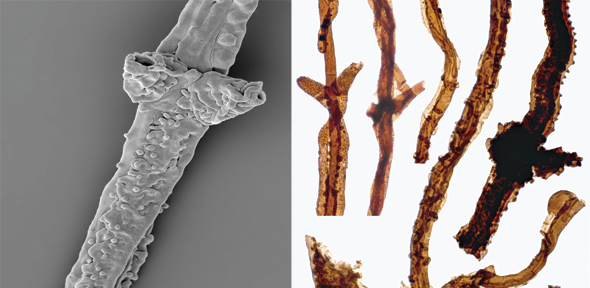
A fossil dating from 440 million years ago is not only the oldest example of a fossilised fungus, but is also the oldest fossil of any land-dwelling organism yet found. The organism, and others like it, played a key role in laying the groundwork for more complex plants, and later animals, to exist on land by kick-starting the process of rot and soil formation, which is vital to all life on land.
This early pioneer, known as Tortotubus, displays a structure similar to one found in some modern fungi, which likely enabled it to store and transport nutrients through the process of decomposition. Although it cannot be said to be the first organism to have lived on land, it is the oldest fossil of a terrestrial organism yet found. The results are published in the Botanical Journal of the Linnean Society.
“During the period when this organism existed, life was almost entirely restricted to the oceans: nothing more complex than simple mossy and lichen-like plants had yet evolved on the land,” said the paper’s author Dr Martin Smith, who conducted the work while at the University of Cambridge’s Department of Earth Sciences, and is now based at Durham University. “But before there could be flowering plants or trees, or the animals that depend on them, the processes of rot and soil formation needed to be established.”
Working with a range of tiny microfossils from Sweden and Scotland, each shorter than a human hair is wide, Smith attempted to reconstruct the method of growth for two different types of fossils that were first identified in the 1980s. These fossils had once been thought to represent parts of two different organisms, but by identifying other fossils with ‘in-between’ forms, Smith was able to show that the fossils actually represented parts of a single organism at different stages of growth. By reconstructing how the organism grew, he was able to show that the fossils represent mycelium – the root-like filaments that fungi use to extract nutrients from soil.
It’s difficult to pinpoint exactly when life first migrated from the seas to the land, since useful features in the fossil record that could help identify the earliest land colonisers are rare, but it is generally agreed that the transition started early in the Palaeozoic era, between 500 and 450 million years ago. But before any complex forms of life could live on land, there needed to be nutrients there to support them. Fungi played a key role in the move to land, since by kick-starting the rotting process, a layer of fertile soil could eventually be built up, enabling plants with root systems to establish themselves, which in turn could support animal life.
Fungi play a vital role in the nitrogen cycle, in which nitrates in the soil are taken up by plant roots and passed along food chain into animals. Decomposing fungi convert nitrogen-containing compounds in plant and animal waste and remains back into nitrates, which are incorporated into the soil and can again be taken up by plants. These early fungi started the process by getting nitrogen and oxygen into the soil.
Smith found that Tortotubus had a cord-like structure, similar to that of some modern fungi, in which the main filament sends out primary and secondary branches that stick back onto the main filament, eventually enveloping it. This cord-like structure is often seen in land-based organisms, allowing them to spread out and colonise surfaces. In modern fungi, the structure is associated with the decomposition of matter, allowing a fungus colony to move nutrients to where they are needed – a useful adaptation in an environment where nutrients are scarce and unevenly distributed.
In contrast with early plants, which lacked roots and therefore had limited interaction with activity beneath the surface, fungi played an important role in stabilising sediment, encouraging weathering and forming soils.
“What we see in this fossil is complex fungal ‘behaviour’ in some of the earliest terrestrial ecosystems – contributing to soil formation and kick-starting the process of rotting on land,” said Smith. A question, however, is what was there for Tortotubus to decompose. According to Smith, it’s likely that there were bacteria or algae on land during this period, but these organisms are rarely found as fossils.
Additionally, the pattern of growth in Tortotubus echoes that of the mushroom-forming fungi, although unambiguous evidence of mushrooms has yet to be found in the Palaeozoic fossil record. “This fossil provides a hint that mushroom-forming fungi may have colonised the land before the first animals left the oceans,” said Smith. “It fills an important gap in the evolution of life on land.”
The research was supported by Clare College, Cambridge.
Reference:
Martin R. Smith. ‘Cord-forming Palaeozoic fungi in terrestrial assemblages.’ Botanical Journal of the Linnean Society 180 (2016). DOI: 10.1111/boj.12389
The earliest example of an organism living on land – an early type of fungus – has been identified. The organism, from 440 million years ago, likely kick-started the process of rot and soil formation, which encouraged the later growth and diversification of life on land.

The text in this work is licensed under a Creative Commons Attribution 4.0 International License. For image use please see separate credits above.